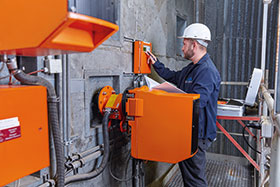

Available agricultural land in Europe is limited. As a result, large quantities of fertiliser are used in order to increase yields. Producing fertiliser, however, is an energy-intensive process which requires monitoring. One of the largest fertiliser manufacturers in Germany chose to use technology from SICK Automation, which includes the installation of over 100 analysers in existing plants.
SICK also developed a self-cleaning in situ measuring probe for reliable gas measurement in environments with wet dusts. Specific monitoring during the processing of phosphate rock and the production of sulphuric acid and phosphoric acid was required. The technology also had to be capable of monitoring processes during the manufacture of mono and diammonium phosphate (MAP/DAP). Until recently, the technology used to measure the gas and dust emissions did not always deliver reliable results.
Technology deployed
Processing of phosphate rock
In most cases, SICK has tried and tested products available ideal for the task at hand. With regard to the processing of phosphate rock, the company needed a product to monitor SO2, NOx, CO, and CO2 as well as dust loads at the outlet of the rotary kilns. The solution had to be able to provide reliable and accurate measurements even in the presence of fine dusts. The GM32 in situ gas analysers were provided for SO2 and NOx, the GM35 for CO and CO2, along with the Dusthunter SP100.
Sulphuric acid production
In the case of sulphuric acid production, the solution had to be able to monitor SO2 and O2 emissions from the stack. In this case, the best choice was the MCS300P HW multi-component analyser system, which requires significantly less maintenance due to its hot/wet extractive measuring technology.
Fluoride
As phosphate rock contains fluoride, HF is released during the production of phosphoric acid and is washed out in the wet scrubber. In order to monitor the performance of the scrubber, HF levels need to be measured on the stack. This task was taken on by the GM700 laser gas analyser, which has a proven track record in the measurement of aggressive and corrosive HF.
Dust emissions, NH3 concentrations and HF emissions
These tasks proved to be a major challenge as the humid, aggressive, and dusty process media made it difficult to take continuous measurements. The chosen solution in this case was the GM700 in situ gas analyser combined with the FWE200 extractive dust measuring device. SICK developed a special measuring probe for the GM700 which cleans itself periodically. The solution can withstand the high levels of salt formation and significantly reduces maintenance. As a result of the continuous monitoring, the excess ammonia in the process can also be cut considerably. The final step was to install eight FWE200 dust measuring devices at one of the sites.
The customer’s key requirements were greater plant safety, fewer failures, lower operating costs, and access to real-time production data. Thanks to SICK Automation’s leading technology, this was achieved and preparations are already under way for a second site.
For more information contact Mark Madeley, SICK Automation Southern Africa, +27 10 060 0550, [email protected], www.sickautomation.co.za
| Tel: | +27 10 060 0550 |
| Email: | [email protected] |
| www: | www.sick.com/za/en/ |
| Articles: | More information and articles about SICK Automation Southern Africa |

© Technews Publishing (Pty) Ltd | All Rights Reserved